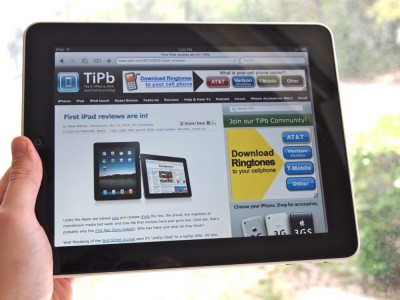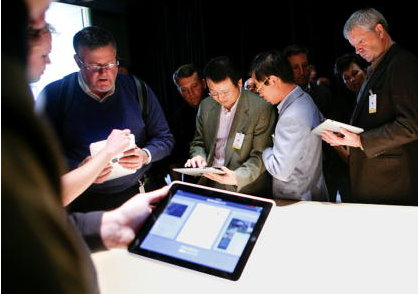When the iPad came out, I expressed concern and disappointment over its highly locked-down nature. Obviously, the iPhone is too, and that’s one reason why I am a big Android fan and supporter. But a locked-down smartphone is one thing. A device that can serve a family’s general home computer use (email, web, etc) being so restricted is, in my mind, another.
On top of that came the new, more restrictive iPhone OS (which is what the iPad runs too) SDK agreement, which essentially terminated the ability to write iPhone and iPad software in any language other than C, C++, or Objective-C. The languages I prefer, namely Ruby and Python, were no longer welcome.
These concerns and disappointments remain as strong as ever.
However, while my intention was to wait for a good Android tablet to come along, life threw a curveball. My boss decided to reward our little core team for a job well done on our big annual job, and she bought us each iPads.
The night before, I had taken my wife to the Apple Store to buy her a 13" MacBook Pro, which is the same laptop I have.
Between the complaints above and Apple’s decision to sue HTC over phone touchscreen patents, I had suggested on Twitter that I might abstain from Apple products in the future. Now the view from my living room couch was two 13" MBPs and an iPad. Clearly, I was failing.
Now, despite my recent misgivings about Apple, I did have some interest in the iPad. Specifically, I wanted something like it for an ebook reader. I have many books and whitepapers in PDF format, and I wanted a nice little tablet that would make reading them much more enjoyable (I had been reading them on my netbook, which was OK but not fabulous). While the e-ink ebook readers are tops in reading comfort, they don’t offer much more than black text.

The iPad’s IPS LED display may not be e-ink, but it is more comfortable to read than older LCD computer screens. With a 99 cent purchase of GoodReader, the iPad has provided the PDF eBook reader I wanted. I expected it to succeed in that capacity. But the iPad has succeeded in other ways that I did not expect.
Like many observers, I saw the iPad as a strange middle ground between a smartphone and a laptop, with netbooks crowding that middle ground even further. And as the owner of an Android smartphone, a netbook (EeePC), a 13" laptop (MacBook Pro), a 17" laptop (Sager), and a desktop PC, it was hard to see where the iPad fit, outside of the ebook functionality.
But upon using it, I found the iPad succeeded in two unexpected spaces: 1. As a social computing device 2. Touchscreen applications impractical for smartphones
I got the first hint of the iPad as a social computing device from this Gamers With Jobs post, where the poster mentioned how nice it was to shop for apartments with his girlfriend on the device, passing it back and forth. I was reminded of that today when reading this blog post, where the author comments on how the iPad has become the kitchentop family computer that everyone simply picks up and uses, and shares.
Since getting my own iPad, I’ve observed this myself. The thing just begs to be passed around. Right down to details like the screen’s extremely high viewing angles, it’s made for casual, shared use, in the way that even a netbook isn’t.
I like the observation of that blog post:
Our iPhones, Androids, and Blackberries are our personal devices. We wear them and they are with us everywhere. Our iPad is our family computer in way that the kitchen macbook never was.
This has spilled over to work. I bring my iPad to work, as the others who received one do as well. Rather than trying to hold up a laptop to show a webpage at a meeting, someone can punch it up on their iPad and easily hold it up or pass it around.
 This is the closest image I could find to people sharing an iPad
This is the closest image I could find to people sharing an iPad
When people say that it’s an overgrown iPhone, I think they are only thinking of the device as a single-user machine. They’re not thinking of dropping it into the middle of a room of people. The device size, screen resolution, and screen quality (especially those viewing angles) make it a whole different beast in a group setting.
The other area where the iPad surprised me is in touchscreen applications that just aren’t viable on a small iPhone screen. One of the ones I’m using at work is iMockups. It’s a $10 app that uses drag-and-drop touch functionality to allow users to quickly make mockups of webpages and web application UIs. I can’t imagine trying to make a webpage mockup on an iPhone touchscreen (or my Android phone), but the big iPad surface and screen resolution allow the kind of precision that makes this task possible.
And, of course, that social, bring-it-to-the-meeting nature of the iPad means I draw up the mockup on the iPad, then bring it to the meeting to pass around.
I’m sure part of my satisfaction has to do with not having to justify its price tag. Having it bought for me takes the “is it worth it?” question completely out of the equation. Naturally, a lot of tech devices look good when cast in that light. But I don’t think I can put myself into that cost/benefit headspace at this point, so I won’t even try. All I can say is that the iPad has definitely talked me out of the “overgrown iPhone” mindset. Using it has made clear to me where it fits in the computing spectrum, where before it seemed to be a device without a home. When looked at not as a personal computing device, but as an ebook reader plus as a social computing device, the iPad’s home becomes clear.